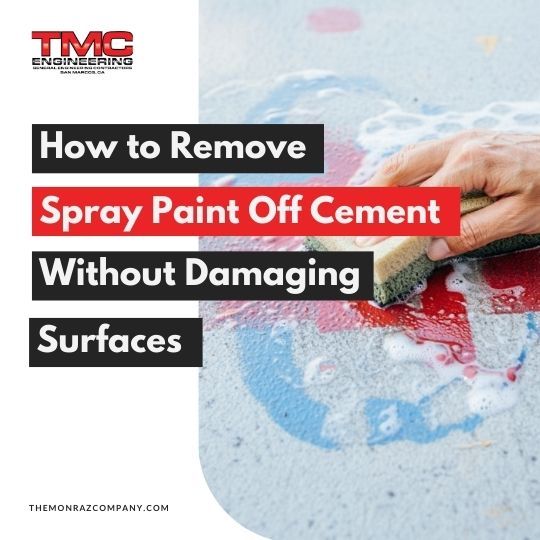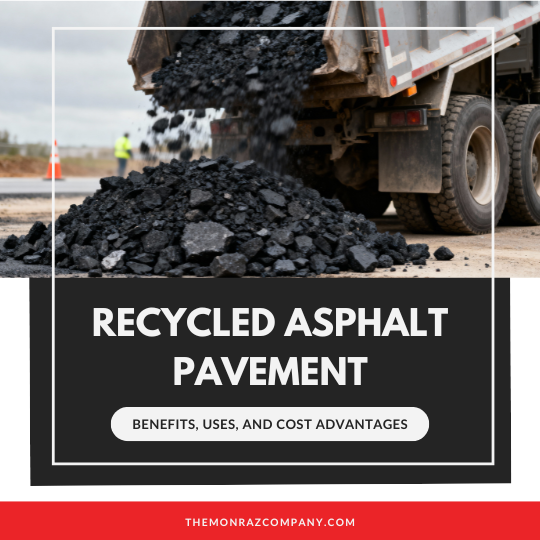15 Sidewalk Edging Ideas for an Aesthetic and Professional Finish
Your business or commercial property’s first impression often comes from its curb appeal. The exterior immediately sets a standard of excellence and communicates the level of professionalism visitors can expect from your service or product. Much of this impression is shaped by the building facade, landscaping, and concrete work.
At first glance, concrete features may seem at odds with creating an aesthetically pleasing exterior. However, concrete paths can be professional,
ADA-compliant, durable,
and visually appealing. One of the most effective ways to achieve this is by thoughtfully selecting the right sidewalk edging for your pavement.
In this post, we’ll explore the appearance, benefits, and costs of each concrete path edging option for your property. If you’d like to discuss your selection with professionals in the Southern California area,
call us at TMC Engineering. We can handle any concrete job, from messy
asphalt removal to elegant finishing touches. We’ll ensure you not only have clean lines, but an edging solution that’s practical, refined, and attractive.
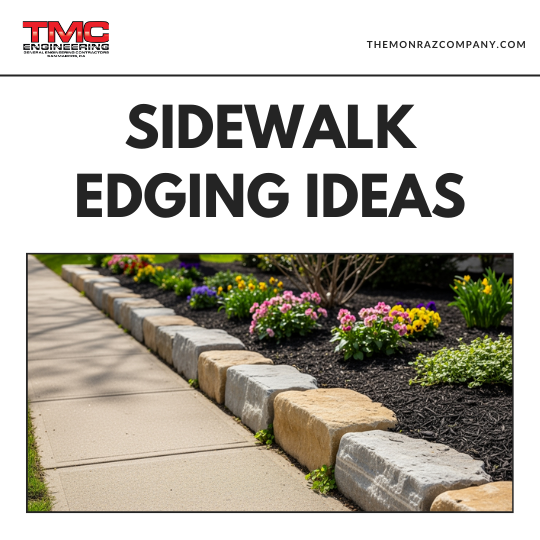
15 Sidewalk Edging Ideas for an Aesthetic and Professional Finish
Before we share specific ideas, it’s important to understand what sidewalk edging is and the different options available. This foundation will help you decide what best fits your property goals, budget, and desired aesthetic.
Additionally, it’s essential to ensure that your sidewalk is level and even for optimal results. To learn more, review our post, “How to Fix
Uneven Sidewalk.” In the meantime, here’s what you need to know about sidewalk edging:
What Is Edging for Sidewalks?
Sidewalk edging refers to the borders of concrete pathways. Primarily, this is what defines the edges to create a clean, polished look. Edging also helps prevent cracking and shifting over time, which extends the life of your concrete. As an additional benefit, sidewalk edging acts as a barrier that keeps pedestrians from stepping onto landscaping, grass, or other nearby features.
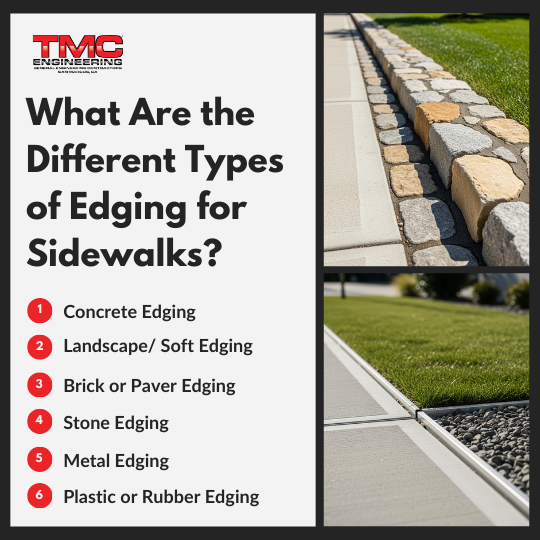
What Are the Different Types of Edging for Sidewalks?
Concrete Edging
Concrete edging presents an efficient and cost-effective option, as it can be completed by the same team installing the sidewalk. As a result, this reduces coordination efforts and eliminates the need for an additional contractor. Additionally, this allows property owners to achieve the desired result more quickly. The finished product is a strong barrier that naturally complements the existing concrete.
The edging can be a raised decorative concrete curb or a level strip with a stamped pattern that mimics stone, brick, or pavers. Concrete borders are versatile, professional-looking, and ideal for commercial or industrial properties.
For more information, read “Stamped Concrete Paint: Updating Decorative Concrete Surfaces with Paint.”
Landscape/Soft Edging
Landscape or soft edging creates a visually appealing, natural finish. However, it offers limited durability long-term when compared to hard materials. Because of this, property owners often choose it for the design flexibility it provides. A minimalist approach might simply involve neatly trimmed grass along the sidewalk, while a more elaborate design could include garden beds, mulch, and decorative plant borders.
This type of edging defines borders and organizes landscaping while allowing property owners to adjust or change the layout over time at a relatively low cost. That said, it requires ongoing maintenance, which can be time-consuming and require additional staffing. For properties that prioritize a relaxed, organic aesthetic, the softer look may justify the additional maintenance.
Brick or Paver Edging
This type of edging uses individual bricks, pavers, or stone blocks laid flush with the sidewalk to create a defined border. Contractors are skilled at laying materials in patterns of your choosing, adding texture and aesthetic appeal.
This method is attractive, easy to repair, and offers a timeless, polished look suitable for any property. Additionally, if a single brick or paver becomes damaged, it can often be replaced by the property owner without hiring a professional. Because of this, brick or paver edging is a practical and moderately priced option.
Stone Edging
Stone edging utilizes natural rocks, boulders, or cut stones to define borders while emphasizing a natural, organic finish. Therefore, many commercial property owners find this process similar to lawn edging. Options such as granite, limestone, or fieldstone provide a durable, low-maintenance solution that does not, however, require the upkeep of traditional landscaping projects.
Stone edging works well with any pavement shape or property terrain, offering flexibility in design. It creates a rustic yet upscale look that enhances both residential and commercial properties. While the upfront cost is typically higher than other options, its durability and timeless appeal make it a lasting, worthwhile investment.
Metal Edging
Metal edging, typically made from steel or aluminum, creates a sleek, modern border that is both functional and visually striking. It is long-lasting, low-maintenance, and resistant to cracking or shifting, making it particularly well-suited for commercial and industrial properties where durability and low upkeep are essential.
The clean, minimalist look of metal edging complements contemporary landscapes and professional settings alike. While installation costs may be higher than some softer options, its strength, longevity, and low maintenance offer sustainable long-term value.
Plastic or Rubber Edging
Plastic and rubber edging are affordable, flexible, and weather-resistant options. Because they are lightweight, easy to install, and hold curves well, they become the ideal solution for winding sidewalks and pathways.
While it requires minimal maintenance and is resistant to cracking, plastic and rubber edging have durability limitations. It is not suitable for areas with heavy equipment or commercial traffic, and its appearance is less professional than that of other hard edging materials. This option is best for residential properties or light-use commercial areas where cost and flexibility are priorities.
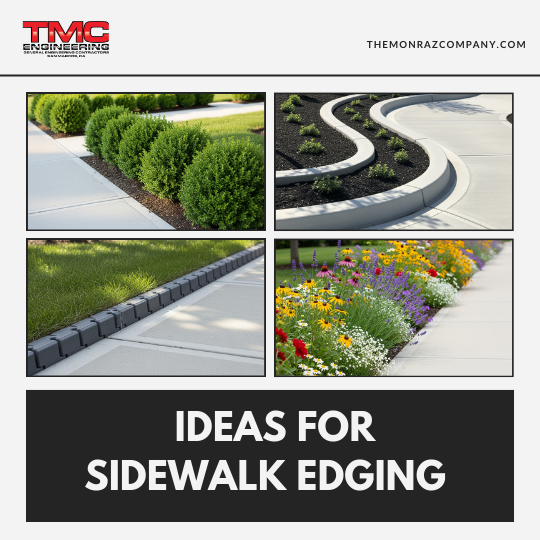
15 Ideas for Sidewalk Edging
Mulch with Seasonal Flowers
For a soft edging option, lay a layer of mulch with seasonal plants and flowers along the pathway. This creates a colorful, texture-rich border that feels natural and welcoming.
Stamped Colored Concrete Bands
Stamped colored concrete bands feature patterned textures and integrated color variations along the edge of a sidewalk or pathway. This creates a polished, decorative appearance with a modern or upscale feel.
Low Boxwood Hedges
Low boxwood hedges are a classic, formal, and timeless soft edging option. It features neatly trimmed evergreen shrubs that define pathways and keep foot traffic off non-paved areas.
Interlocking Plastic Paver Border
Interlocking plastic pavers form a continuous, uniform edge along sidewalks. The result is a clean, cohesive aesthetic that appeals to property owners seeking a low-maintenance, casual solution.
Historic Cobblestone Strip
In this option, narrow traditional cobblestones line the edges of sidewalks, creating a striking contrast with the concrete pathway. It evokes a historic, charming, and old-world feel.
River Rock Border
Smooth, rounded stones, approximately 206 inches in diameter, are placed along walkways or flower beds to define their edges. This creates a natural, rustic, and relaxed look.
Colored Concrete Band
A simple strip of dyed concrete along the edge of a sidewalk or driveway. This design adds a modern, polished accent while maintaining a minimalist aesthetic.
Wildflower Strip
A native wildflower strip offers a soft-edging option with less maintenance than manicured garden beds. However, the result remains colorful, informal, and visually integrated with the natural landscape.
Herringbone Brick Border
Bricks laid in a herringbone pattern along paths create a structured, classic, and visually striking look. Contractors can use traditional clay bricks, concrete pavers, or reclaimed bricks, each offering a slightly different texture and color palette.
Curved Concrete Ribbon
Narrow concrete edging is shaped into gentle curves along paths or garden beds. This design creates a sleek and fluid final look for property owners seeking a modern aesthetic.
Stacked Stone Edge
For a rustic and maximalist design, consider natural or cut stones stacked to create a raised or layered border. Contractors can mortar stones for extra stability or leave them dry-stacked for a more natural, flexible arrangement.
Reclaimed Brick Border
Salvaged bricks provide a cost-effective and timeless edging solution. This option works particularly well for older commercial and industrial properties, adding character while blending seamlessly with existing architecture.
Mosaic Stone Inlay
Small stones are carefully arranged in intricate patterns along the edge of a walkway, creating a visually engaging border. This technique adds texture, color variation, and an artistic, high-end appearance.
Powder-Coated Steel Border
Contractors finish steel strips with a durable powder coating to create clean, precise edges along pathways. The final look is suitable for contemporary or industrial properties looking for a minimalist edging solution.
Exposed Aggregate Concrete Strip
Exposing the aggregate in the concrete reveals embedded stones or pebbles that define the walkway's edge. This technique creates a textured, sophisticated, and decorative finish, adding subtle visual interest.
Concrete edging creates professional curb appeal and defined borders.
Choosing the right sidewalk edging can transform the appearance of your property, creating clean lines, professional curb appeal, and a lasting first impression. Whether your preference leans toward durable concrete, elegant brick or stone, sleek metal, or flexible rubber, there are plenty of options to choose from. Additionally, each material offers unique benefits to meet both aesthetic and functional goals. To understand more about sidewalks, check out our post, "How Wide Is a Standard Sidewalk: Guidelines for ADA Compliance."
For expert installation and guidance on choosing the perfect edging for your property,
contact TMC Engineering. Our team of experts ensures every project is durable, polished, and tailored to your style. We can provide a professional service and expert guidance when choosing the best edging solution for your unique commercial or industrial property.
If you’re interested in additional services to update the appearance of your concrete pathways, read these articles from the TMC experts:
